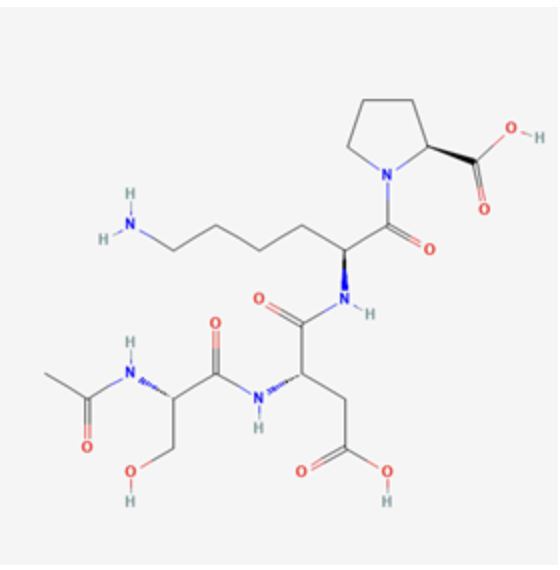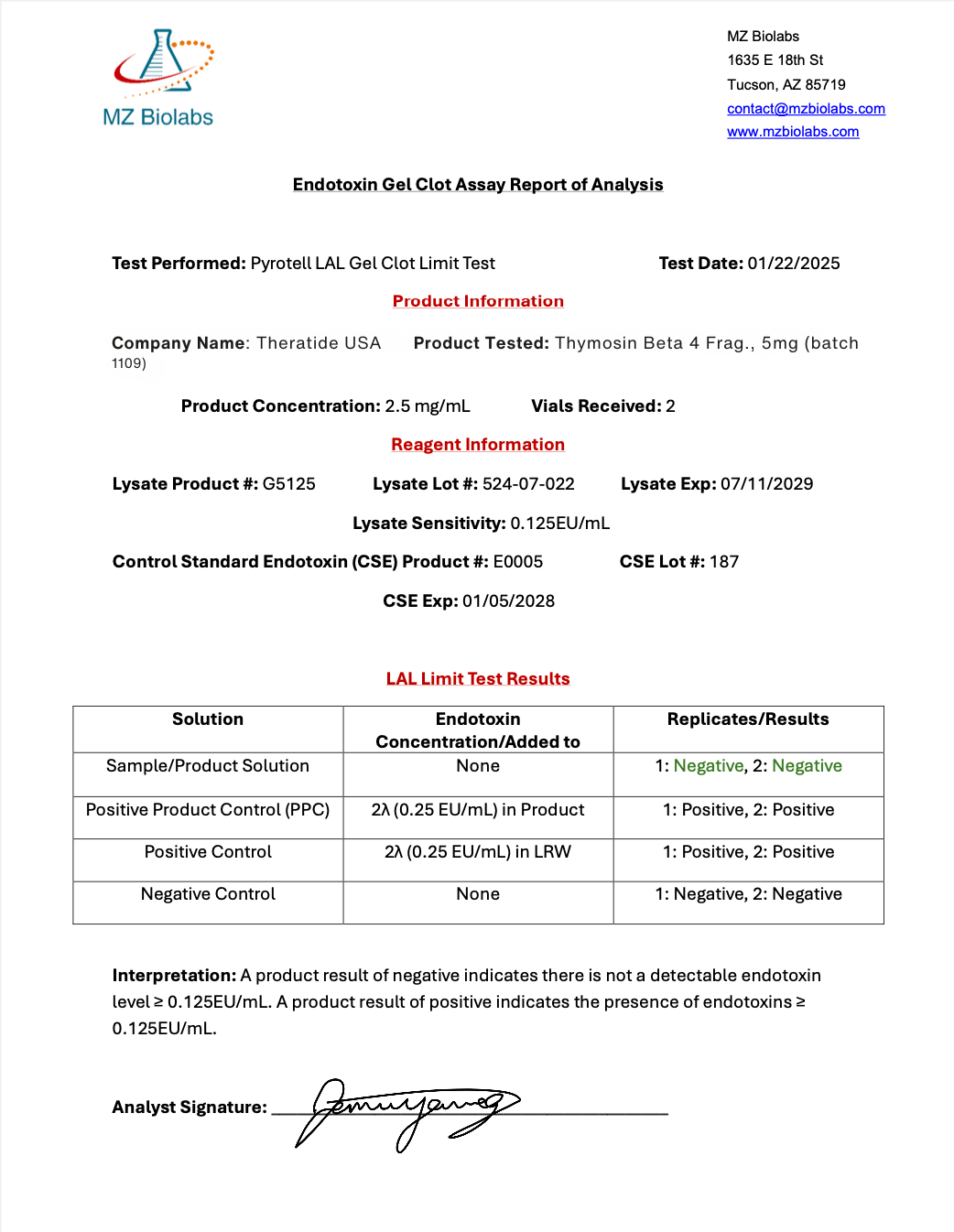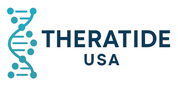Product Overview
Product Overview
Thymosin Beta-4 Fragment (1–4) (Ac-SDKP) Overview
Ac-SDKP (N-acetyl-seryl-aspartyl-lysyl-proline) is a naturally occurring tetrapeptide derived from the large thymosin beta-4 protein. Research in animal models has shown Ac-SDKP to have anti-inflammatory, pro-angiogenic, and anti-scarring properties. It has been proposed as a potential therapeutic agent for a variety of conditions, including cardiovascular disease, kidney and liver fibrosis, and inflammatory bowel disease. The peptide may even offer a more natural mechanism for the treatment of high blood pressure, in part due to its association with angiotensin-converting enzyme.
Structure

Sequence: Ac-Ser-Asp-Lys-Pro
Molecular Formula: C20H33N5O9
Molecular Weight: 487.5 g/mol
CAS Number: 120081-14-3
Synonyms: goralatide, seraspenide
Mechanism of Action & Research
At its most basic level, Ac-SDKP works by modulating the immune response. In animal models it has been shown to activate certain immune pathways responsible for bolstering anti-inflammatory responses, modulating the release of proinflammatory factors, reducing tissue infiltration by T-cells, and promoting the differentiation and migration of macrophages. It is also known to suppress production of TGF-beta, a driver of fibrosis, and to inhibit oxidative stress. Research suggests its activity is mediated through MEK-ERK signaling, contributing to reduced collagen synthesis, reduced scar tissue, and improved healing outcomes.
Anti-Inflammatory and Fibrosis Effects
Ac-SDKP reduces macrophage activation, inflammatory cytokine release, and prevents fibrotic conversion of fibroblasts. In animal models of inflammatory bowel disease, heart fibrosis, and kidney disease, Ac-SDKP has been shown to significantly improve tissue health and reduce markers of damage. In models of heart injury, it even reverses established fibrosis and improves cardiac function.
Additional Research Highlights
- Protective effects against high blood pressure through ACE pathway modulation
- Potential use as an adjuvant to chemotherapy and radiotherapy to reduce tissue damage
- Evidence for protective and regenerative effects in the brain after stroke, due to its ability to cross the blood-brain barrier and regulate fibrin activity
Disclaimer
ALL ARTICLES AND PRODUCT INFORMATION PROVIDED ON THIS WEBSITE ARE FOR INFORMATIONAL AND EDUCATIONAL PURPOSES ONLY.
The products offered on this website are furnished for in-vitro studies only. In-vitro studies (Latin: in glass) are performed outside of the body. These products are not medicines or drugs and have not been approved by the FDA to prevent, treat, or cure any medical condition, ailment, or disease. Bodily introduction of any kind into humans or animals is strictly forbidden by law.

Storage Instructions
All of our products are manufactured using the Lyophilization (Freeze Drying) process, which ensures that our products remain stable for shipping for up to 3–4 months. Once the peptides are reconstituted (mixed with bacteriostatic water), they must be stored in the refrigerator to maintain stability for up to 30 days.
Lyophilization is a unique dehydration process, also known as cryodesiccation, where the peptides are frozen and then subjected to low pressure. This causes the water in the peptide vial to sublimate directly from solid to gas, leaving behind a stable, crystalline white structure known as lyophilized peptide. The puffy white powder can be stored at room temperature until you're ready to reconstitute it with bacteriostatic water.
For longer-term storage (several months to years), it is preferable to store peptides in a freezer at -80°C (-112°F). When storing peptides for months or even years, freezing is optimal in order to preserve the peptide’s stability.
For further information on proper storage techniques, click the link below:
TB-500 vs. TB-500 Fragment (1–4) vs. TB-500 Fragment (17–23)
Which part of healing are you researching? Here’s a clear explanation of how they differ.
What is actin binding and why does it matter?
Actin is a key structural protein inside cells, forming a framework that helps cells keep their shape and move. During healing, repair cells need to move into the damaged area to rebuild tissue. Actin-binding describes how a molecule interacts with actin to help cells reorganize and migrate to the injury site. Without actin-binding, wound healing can be slower and less effective because cells are unable to move efficiently.
TB-500 (Full) – The All-Around Healing Peptide
TB-500 is the full 43-amino-acid Thymosin Beta-4 molecule. It has broad, well-documented healing effects, including:
- Promoting cell movement through actin binding
- Reducing inflammation
- Stimulating new blood vessel growth (angiogenesis)
- Supporting repair of muscle, skin, tendons, and heart tissue
Examples of use: Healing torn ligaments, surgical wounds, burns, ulcers, and supporting heart tissue recovery.
Best when: A full, proven, all-around healing effect is desired.
TB-500 Fragment (1–4) – Focused on Cell Movement
TB-500 Fragment (1–4) is the first four amino acids of the full molecule. This fragment is believed to be responsible for actin-binding and helping cells migrate into wounds.
- Highly focused on cell movement and motility through actin dynamics
- Does not significantly impact inflammation or angiogenesis
Examples of use: Researching scar tissue formation, studying how skin or fibroblast cells migrate, and chronic wound cell motility studies.
Best when: Research focuses specifically on actin-driven cell movement and wound closure, without systemic effects.
TB-500 Fragment (17–23) – Triggering Healing Signals
TB-500 Fragment (17–23) is a different small section of the full molecule. It is believed to carry the core signal that instructs tissue to begin repair, without directly helping cells move or binding actin.
- Stimulates the tissue repair signaling process
- Does not directly support cell migration or angiogenesis
Examples of use: Researching wound healing signals in diabetic ulcers, topical gels for localized repair, or studies on healing in delicate or cosmetic areas.
Best when: Research focuses on how tissues are signaled to start healing, rather than on how cells move or grow blood vessels.
Comparison Table
| TB-500 (Full) | Fragment (1–4) | Fragment (17–23) | |
|---|---|---|---|
| Main function | Broad healing: inflammation, angiogenesis, repair, and cell movement | Actin binding and cell migration | Healing signal activation |
| Best for… | Full-spectrum healing and repair | Actin-driven cell migration studies | Wound signaling mechanism studies |
ALL ARTICLES AND PRODUCT INFORMATION PROVIDED ON THIS WEBSITE ARE FOR INFORMATIONAL AND EDUCATIONAL PURPOSES ONLY. The products offered on this website are furnished for in-vitro studies only. In-vitro studies (Latin: in glass) are performed outside of the body. These products are not medicines or drugs and have not been approved by the FDA to prevent, treat, or cure any medical condition, ailment, or disease. Bodily introduction of any kind into humans or animals is strictly forbidden by law.








